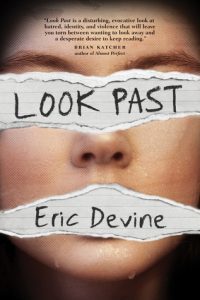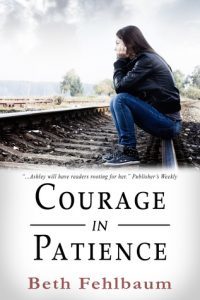Kathy Lynn Emerson's Blog, page 60
November 3, 2016
The Perfect Game
Seriously, Cass? More baseball stuff? Well, feel free to move along if you don’t have a yen for The Perfect Game but if you stick around, I’ll try to connect it to something closer to our hearts.
The great Rogers Hornsby, famous baseball player and manager, was once asked how he amused himself after the baseball season was over. “I’ll tell you what I do,” he said. “I stare out the window and wait for spring.”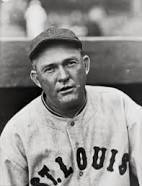
Well, by the time this post appears, the 2016 World Series will be history and regardless of who triumphs, all of us who are fanatic about the game will sit down to stare out the window until spring . . training . . arrives. In the spirit of that, I’ve been contemplating how much trying to write a book reminds me of playing a baseball game.
The first and most obvious resemblance is the air of utter uncertainty at the beginning of things. Entering the ball park, you are confronted with the tabula rasa of the emerald field, some of its features standard from park to park (pitcher’s mound to home plate, the distance between the bases) and some unique (the Pesky Pole in Fenway,  the brick outfield wall in Wrigley). Is there another sport where the ground rules change from venue to venue?
the brick outfield wall in Wrigley). Is there another sport where the ground rules change from venue to venue?
Within all that blank and unruly space lies the possibility there is in the game—either game—and all the uncertainty of how to begin and where to go. For an instant, before the work begins, everything is clean and hopeful and perfect. And then . . the first pitch. The first sentence. And if you read a lot, other writers’ first sentences can stall you right there. You want to throw a strike.
“None of the merry-go-rounds seemed to work any more.” (John Dunne, True  Confessions)
Confessions)
“Sunday morning, Ordell took Louis to watch the white-power demonstration in downtown Palm Beach.” (Elmore Leonard, Rum Punch)
“Jackie Brown at 26, with no expression on his face, said that he could get some guns.” (George V. Higgins, The Friends of Eddie Coyle)
You launch into your book with no more idea what is about to happen on the field than the peanut vendor high in the left field bleachers. You hope you can write a sentence that draws like one of those. The game begins. But slowly. Thoughtfully.
From the first pitch, the first words set, you are now the impatient victim of incremental progress. Each ball, each sentence, sends you deeper into the construction, the whole you will not see before it’s done. You lay your words in, make your pitches and take your at-bats, bit by bit, moment by moment, each one building on the ones that came ahead of it and those that might come after. But ever so slowly, with much staring and spitting and rubbing up the tools of your game. Each tiny mote of effort lives in and of itself and at the same time, contributes to a whole.
What is beautiful about this incremental process, though, what makes it both difficult and addicting, is the endless possibility. With each pitch, each word, idea, and sentence you throw out, you create a further place of possibility. What comes next? A bunt? A full swing? Fast ball or slider? A bit of dialogue, some description, a little backstory? Each bit sends you in a new direction, into more possibility, and more, until the possibilities begin to limit themselves by what has preceded them. And then you can only bet on certain acts, certain words, to take you to the end in sight.
And hovering over the whole, always? Failure. The best hitter in baseball—Ted Williams, please; 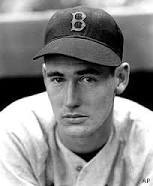 Joe me no DiMaggios—only hit the ball safely four times out of ten. Most writers I know would accept that rate of success in a heartbeat. And truly? Isn’t that part of why we continue pitching the balls, swinging the bat, moving the pen? Nothing in what we do is perfectible and if it were that easy to succeed, everyone would want to do it. And none of it would mean as much.
Joe me no DiMaggios—only hit the ball safely four times out of ten. Most writers I know would accept that rate of success in a heartbeat. And truly? Isn’t that part of why we continue pitching the balls, swinging the bat, moving the pen? Nothing in what we do is perfectible and if it were that easy to succeed, everyone would want to do it. And none of it would mean as much.
I had a student tell me once she wished to have written a book, by which I understood she wasn’t yet willing to commit to the plodding, necessary, sometimes nasty work of shaping her ideas, building her story, learning her characters. I hope she eventually learned what she would have to do to bring her wish into the present.
Because the final similarity is this: really, no one much cares what you’re doing. It’s at bottom, a game—an important one, but still only a game—and when the stands are empty, when you type The End, your pleasure is likely not in the product you’ve ended up with, but with the time you’ve spent inside the game. The process, folks. Much as we love the sunshine of fame (minor or major), the win, we have to love to play the game even more.
Introducing Eggnog Murder and Christmas Traditions
by Barb, who’s finally admitting the days are getting shorter, the temperatures colder. Sigh.
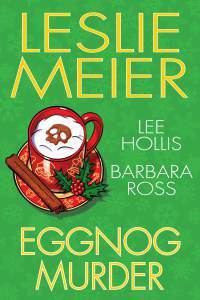 This is official Kensington release week for Eggnog Murder in hardcover, ebook and audiobook. The large print edition is coming in early December. Eggnog Murder is getting some great reviews, including a starred review from Publishers Weekly!
This is official Kensington release week for Eggnog Murder in hardcover, ebook and audiobook. The large print edition is coming in early December. Eggnog Murder is getting some great reviews, including a starred review from Publishers Weekly!
The book is a collection of three holiday novellas all set in coastal Maine. The other stories are by well-known cozy authors Leslie Meier and Lee Hollis. We were all given the same assignment by Kensington– 25,000 to 35,000 words, and the words “eggnog murder.” It’s fascinating to see where each of us went from there. Since this is a Maine blog, I thought it might be interesting to find out where each of us found the holiday traditions for our towns.
 Leslie Meier is the New York Times bestselling author of over twenty Lucy Stone mysteries and has also written for Ellery Queen’s Mystery Magazine. She is currently at work on the next Lucy Stone mystery. Readers can visit her website at www.LeslieMeier.com. Leslie’s novella is titled “Eggnog Murder.”
Leslie Meier is the New York Times bestselling author of over twenty Lucy Stone mysteries and has also written for Ellery Queen’s Mystery Magazine. She is currently at work on the next Lucy Stone mystery. Readers can visit her website at www.LeslieMeier.com. Leslie’s novella is titled “Eggnog Murder.”
Leslie: The Lucy Stone Mystery Series draws heavily on holidays, and I do rely on the holiday celebrations that take place in my town, Harwich, Mass. as well as ones in Maine, where I vacation every summer, and also my own family traditions. Candy Corn Murder was inspired by the Pumpkin Fest in Damariscotta, Maine, which is the next town from Bristol, where we always stay in a cabin owned by family members. I must confess I never actually attended the entire Pumpkin Fest in Damariscotta, as it takes place in the fall, but they have a nice website that was very helpful.
I also worked for some years as a small town reporter for local weekly newspapers on Cape Cod so I have covered and written about many local festivals, which have popped up in my books. One of my favorite characters, Corney Clark, is the executive director of the Tinker’s Cove Chamber of Commerce, and she is always working hard to promote business in Lucy’s fictional home town. Corney came up with the idea for a Christmas stroll, which was an important part of my novella, “Eggnog Murder,” and my husband and I always enjoy the annual holiday strolls in our town of Harwich and in nearby Chatham. I always hope for a little light snow to fall for the strolls, and some times it does. Fortunately for us, nobody has served poisoned eggnog — not yet, anyway!
 Lee Hollis is the pen name for a brother and sister writing team. Rick Copp is a veteran film and television writer/producer and also the author of two other mystery novel series. He lives in Palm Springs, California. Holly Simason is an award-winning food and cocktails columnist living in North Carolina. Together they write the Hayley Powell Food and Cocktails Mystery series. You may visit their website at www.LeeHollisMysteries.com. their story is titled, “Death by Eggnog.”
Lee Hollis is the pen name for a brother and sister writing team. Rick Copp is a veteran film and television writer/producer and also the author of two other mystery novel series. He lives in Palm Springs, California. Holly Simason is an award-winning food and cocktails columnist living in North Carolina. Together they write the Hayley Powell Food and Cocktails Mystery series. You may visit their website at www.LeeHollisMysteries.com. their story is titled, “Death by Eggnog.”
Holly (one half of the team behind author Lee Hollis): “Death by Eggnog” in Eggnog Murder is set in our hometown of Bar Harbor, Maine. We love using real Bar Harbor traditions, events and places in our stories. In “Death By Eggnog” we used a little fact and fiction creating the event/venue where all of the excitement happens.
Bar Harbor has many, many restaurants but at the end of the season, as the last tourists leave, there is just a small handful left open for the winter months, so we created the Restaurant Association dinner at the Masonic Hall where our murder takes place.
There isn’t exactly a association dinner but there have been local restaurants getting together for a good cause and creating some of their favorite dishes that people can sample for an admission fee that helps out a good cause.
The Masonic Hall is a real venue used by locals for birthday parties, anniversaries, baby showers, dances (like our Hayseed Ball we used in another book) and I even had the privilege of judging a chocolate competition there when I was working for the local newspaper, The Mount Desert Islander.
We have school children singing Christmas carols at the Jesup Memorial Library which is true during the holiday season when the local pre-school stops by, but they are better received then how the children were in our story.
We have also used the town’s annual Christmas tree lighting in another one of our books that was set during the holidays.
We love taking fact and mixing it up with some fiction and our readers have let us know that they love it too. Some say they feel that they are in the story right along with our characters. This make us very happy to hear and we just love our hometown and the people in it.
One quick note, Rick and I have an agreement that if a murder takes place in a local establishment we won’t use the true name. We always make up a new name for it. We would hate for someone to think there was some truth in the story. Yikes!

Barb shopping in her pajamas
Barb: My story is “Nogged Off.” I’ve never written a Christmas story about my fictional town of Busman’s Harbor before, and I was thrilled to do it.
I used a combination of real Boothbay holiday events, like the Saturday everyone shops in their pajamas (I’ve written about that here) and Men’s night. I’ve called it Gentlemen’s Night in the novella, because it evokes the feel of time when men only had to buy one present and their wives took care of the rest. (My father had a strict policy of only buying gifts at places that gift-wrapped. “I will shop, but I will not wrap,” he’d say.)
Boothbay does have a Festival of Trees, but the one I describe in “Nogged Off,” is much more like the one at the Navy base in Newport, Rhode Island, where my friend Vida and I used to take our kids when they were little. Other traditions, like the Snowden’s “cookie day” came from my own life.
Because the novella takes place over four days, the timeline for all the local events is compressed. In real life they start before Thanksgiving and continue through December. The biggest holiday attraction in Boothbay, Gardens Aglow, at the Boothbay Botanical Gardens, just started last year, and was too new to make it into the book. I guess that leaves me something to include if I ever get another chance to write about a Busman’s Harbor Christmas.
We hope you enjoy Eggnog Murder, and we hope you agree we’ve captured something of the holiday in Maine.
Save
Save
Save
Save
Save
Save
Save
Save
Save
Save
Save
Save
Save
November 1, 2016
Want to sample Maine’s mystery writers? Here’s your chance.
I’ve never really gotten it when people tell me they don’t read mysteries or don’t like mysteries. Particularly when I’m told it by someone who’s read one of my books, and says they “enjoyed it, even though I don’t usually (whatever) mysteries.”
Mystery, as a genre, is funny. There are so many sub-genres, so many differences, that “mystery” is really difficult to categorize. Some people have told me they don’t read them because they’re too scary or gory, there’s too much violence. But there are many that simply aren’t scary, gory or violent and are still good reads. Some people have told me they have trouble following the plots. Confession: I often do, too. But that doesn’t bother me.
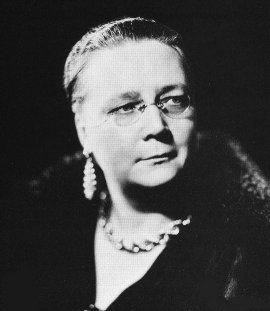
Dorothy L. Sayers, author of the Lord Peter Wimsey mysteries. (Photo courtesy Sayers.org.uk)
I’ve read Dorothy L. Sayers MURDER MUST ADVERTISE maybe a dozen times, and there are still things about the plot I don’t get (or maybe it’s just that cricket game that takes up a whole chapter). Yet, it’s one of my favorite mysteries. Same goes for Sayers’ THE NINE TAILORS, though maybe it’s just church bell-ringing. Sayers was so good with character and story the plot was an afterthought as far as I was concerned, though it obviously wasn’t to her. Her plots are as excellently drawn as the rest of her books.
As you may have guessed, I’m not a big plot person. With most books, not just those by the great DLS, I just let plot wash over me a lot of the time and am usually surprised if I figure the whole thing out. I’m much more interested in the characters and what they’re doing and how they feel and how they relate to each other and what’s going on in the story that’s carried along by the plot (or vice-versa). Writing-wise, this can be a challenge for me, but that’s a blog post for a different day.
There are also people who are all plot, all the time. Neither of us are “right” or “wrong.” Cozy? Thriller? Hard boiled? Whatever. None of it is right or wrong and none alone defines “mystery.” Say to me that you “don’t like” mysteries, and I bet you just haven’t found the right kind.
That’s one reason why I’m so excited about Sunday’s upcoming Noir @ the Bar event in Portland. A dozen Maine crime and mystery writers, many of whom are regular contributors to blog or guest contributors, are going to read short passages from their work. What better way to sample the variety we offer?
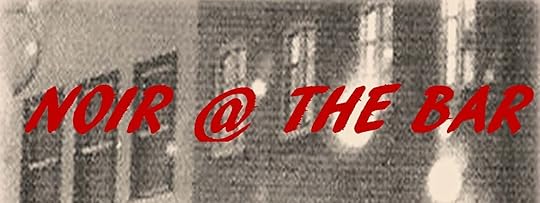
Noir @ the Bar is 3-5 p.m., Sunday, November 6, at Bull Feeney’s, 375 Fore St., Portland. To find out more, go to the Noir @ the Bar Facebook page.
Participants include:
JEN BLOOD: Author of the popular Erin Solomon series, she’s put her dog training background to work with the release this month of THE DARKEST THREAD, the first in the Flint K-9 Search and Rescue series. Find out more about Jen at jenblood.com.
BRENDA BUCHANAN: Brenda, an attorney and former journalist, is author of the Maine-based Joe Gale mystery series, the third of which, TRUTH BEAT, was released earlier this year. To find out more about Brenda, go to brendabuchananwrites.com.
DICK CASS: Dick is the author of SOLO ACT, a jazz mystery featuring sleuth Elder Darrow, as well as many short stories. Find out more about Dick at his Facebook page, Dick Cass – Writer.
BRUCE ROBERT COFFIN: Bruce, a retired Portland police detective sergeant, is the author of recently released, AMONG THE SHADOWS, his debut mystery novel, the first in the John Byron series. Find out more about Bruce at brucerobertcoffin.com.
JESSICA ESTEVAO (aka JESSIE CROCKETT): As Jessie Crockett, she’s author of the Sugar Grove Mysteries; as Jessica Estevao, her first Change of Fortune mystery, WHISPERS BEYOND THE VEIL, came out this fall. To learn more about her, go to jessicaestevao.com.
E.J. FECHENDA: E.J. is the author of the New Mafia Trilogy and numerous short stories. Find out more about her at her Facebook page, EJ Fechenda Author or her Amazon author page, EJ Fechenda.
GAYLE LYNDS: Described as the “reigning queen of the espionage thriller,” Gayle’s new thriller THE ASSASSINS, was recently released. Learn more about Gayle and her books at gaylelynds.com.
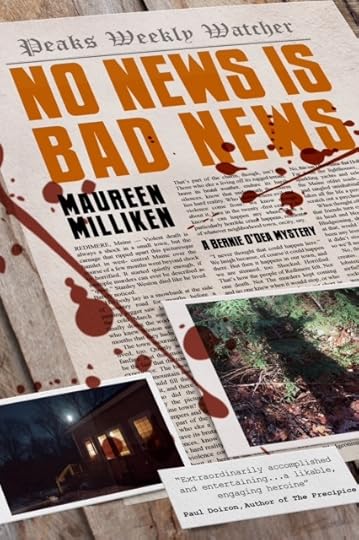
No News is Bad News, the second in the Bernie O’Dea mystery series.
MAUREEN MILLIKEN: That’s right, me! I’m a former journalist and the second in my Maine and journalism-based Bernie O’Dea mystery series, NO NEWS IS BAD NEWS, was released this summer. Find out more about me and my books at maureenmilliken.com.
BRENDAN RIELLY: Brendan’s books range from a tongue-in-cheek guide to parenting to his thriller AN UNBEATEN MAN, released last year and named 2016 Best Crime Fiction winner by the Maine Writers and Publisher’s Association. To learn more about Brendan, go to riellybooks.com.
BARB ROSS: Barb is the author of the popular Maine Clambake mystery series. The latest, ICED UNDER, comes out next month. To find out more about Barb, go to maineclambakemysteries.com.
JOHN C. SHELDON: John is a former attorney, including a stint as a Franklin County prosecutor, and is now a legal mediator and arbitrator. He has collaborated on three published mystery short stories with his wife, Gayle Lynds.
JULIA SPENCER FLEMING: A New York Times bestselling author, Julia writes the Rev. Clare Fergusson/Russ Van Alstyne suspense mysteries, which feature an Episcopalian minister. For more on Julia and her books, go to juliaspencerfleming.com.
So, see? I defy you to leave Noir @ the Bar without hearing something that you think you’d like to read more of. On top of that, we’re a fun group. Come on over and check us out.
Maureen Milliken is the author of the Bernie O’Dea mystery series. Follow her on Twitter at@mmilliken47 and like her Facebook page at Maureen Milliken mysteries. Sign up for email updates at maureenmilliken.com.
October 31, 2016
Sleep, Glorious Sleep!
Kaitlyn Dunnett/Kathy Lynn Emerson here, this time to share the joys of undergoing a sleep study in order to discover if I have sleep apnea or not.
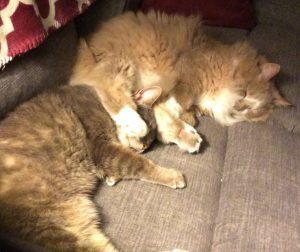
other members of the family never have any trouble sleeping
Back in April, my husband reported that I was showing classic symptoms of sleep apnea—I’d stop breathing while sleeping, then wake myself up with a start. Of course, I had no idea I was doing this, since I was asleep. I was skeptical to begin with, but a little research told me that sleep apnea could be a contributing cause of my high blood pressure, the panic attacks I occasionally have while at writers’ conferences, and a couple of relatively minor ailments I’ve suffered from, on and off, over the years. I suppose I never thought of sleep apnea before because I’ve always been a restless sleeper and I tend to make good use of that new upstairs bathroom we installed last summer. Quite often, I also get up for a half hour or so in the middle of the night and read until my restless leg syndrome calms down.
It took me some time to get an appointment with my primary care physician (she’s very popular and this wasn’t an emergency) and then there was another wait for an appointment at the Sleep Center at Franklin Memorial Hospital in Farmington, but eventually I was scheduled to report in at 7:30 on an early October evening and spend the night being monitored.
It will be an adventure, I told myself. I can use this in a blog, I said. Well, both predictions turned out to be true, but my biggest takeaway is the realization that very little in life is better than getting a good night’s sleep.
 The sleep study involved being monitored while I slept. I signed a paper giving permission for a camera to record my movements during the night. Then the polysomnographic technician attached wires to my head to record brain waves, which would tell her if I was asleep and how deeply. Another wire was attached to my finger to make sure I was getting enough oxygen. More wires made sure my heart was beating. All of these fed into a unit mounted on the wall. Fortunately, it could be detached and hung over my shoulder like a purse when I had to get up to use the bathroom.
The sleep study involved being monitored while I slept. I signed a paper giving permission for a camera to record my movements during the night. Then the polysomnographic technician attached wires to my head to record brain waves, which would tell her if I was asleep and how deeply. Another wire was attached to my finger to make sure I was getting enough oxygen. More wires made sure my heart was beating. All of these fed into a unit mounted on the wall. Fortunately, it could be detached and hung over my shoulder like a purse when I had to get up to use the bathroom.
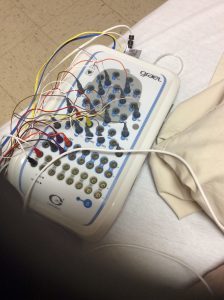 I was told that if I did show signs of having sleep apnea, I might be awakened and fitted with a CPAP (continuous positive airway pressure) mask, but that if those signs didn’t snow up until late in the study (after 3AM), I might have to come back for another session because there wouldn’t be time to tell if the treatment was working. With that information to mull over, I was left on my own while my technologist went off to set up the second patient she’d be monitoring overnight.
I was told that if I did show signs of having sleep apnea, I might be awakened and fitted with a CPAP (continuous positive airway pressure) mask, but that if those signs didn’t snow up until late in the study (after 3AM), I might have to come back for another session because there wouldn’t be time to tell if the treatment was working. With that information to mull over, I was left on my own while my technologist went off to set up the second patient she’d be monitoring overnight.
I passed the time reading (big surprise!) and since I usually go to bed between 10 and 11, I was already yawning when she came back to announce lights out at 10:30. To aid in sleeping, I’d brought my own pillow. The bed, although narrow, was comfortable, but I was trailing at least a dozen wires, which made turning over a little tricky.
I think you can guess what happened. Could I fall asleep? Of course not. Toss. Turn. Toss. Turn. Accidentally detach one of the heart-monitor wires and have to be hooked up again. Get up and pee. Repeat. Repeat. Repeat. At one point I asked if I’d slept at all. The answer was “a little.” I did eventually sleep, but I doubt I got more than an hour’s total and by then it was way too late to experiment with the CPAP. I don’t even know if I stopped breathing at any time during the session. By the time the technologist got me up at 5 AM to unhook everything and send me home, I wasn’t exactly at my best. I never thought to ask.
I went home and went back to bed. I didn’t sleep all that long, but I slept hard. It took me another week to get back to my normal restless sleep pattern—not great but at least familiar. Meanwhile, my hair was in terrible shape—lots of breaks and split ends—thanks to the gunk used to glue the wires in place on my head. Getting a comb through it brought back the not-so-good old days of teasing and hair spray. That, too, is finally back to normal, but somewhat the worse for wear.
So now it’s a little over three weeks later. I was hoping to be able to report on the results of my sleep study in this blog, but I haven’t heard anything yet. My husband, however, has reported more incidents of the stop-breathing thing.
Will I go return for another try if that’s what the report suggests? I’m not sure I will, although I’m game to experiment with the CPAP. To be honest, the best thing about the experience so far has been the response to posting about it on Facebook. Who knew so many people would kill for a good night’s sleep?
 Kathy Lynn Emerson/Kaitlyn Dunnett is the author of over fifty books written under several names. She won the Agatha Award for best mystery nonfiction of 2008 for How to Write Killer Historical Mysteries and was an Agatha Award finalist in 2015 in the best mystery short story category for “The Blessing Witch.” Currently she writes the contemporary Liss MacCrimmon Mysteries (Kilt at the Highland Games) as Kaitlyn and the historical Mistress Jaffrey Mysteries (Murder in a Cornish Alehouse ~ UK in December 2016; US in April 2017) as Kathy. The latter series is a spin-off from her earlier “Face Down” series and is set in Elizabethan England. Her websites are www.KaitlynDunnett.com and www.KathyLynnEmerson.com
Kathy Lynn Emerson/Kaitlyn Dunnett is the author of over fifty books written under several names. She won the Agatha Award for best mystery nonfiction of 2008 for How to Write Killer Historical Mysteries and was an Agatha Award finalist in 2015 in the best mystery short story category for “The Blessing Witch.” Currently she writes the contemporary Liss MacCrimmon Mysteries (Kilt at the Highland Games) as Kaitlyn and the historical Mistress Jaffrey Mysteries (Murder in a Cornish Alehouse ~ UK in December 2016; US in April 2017) as Kathy. The latter series is a spin-off from her earlier “Face Down” series and is set in Elizabethan England. Her websites are www.KaitlynDunnett.com and www.KathyLynnEmerson.com
October 30, 2016
What scares the Maine Crime Writers?
BOO! Scared you, right? Okay, maybe not. But it’s Halloween and there are a lot of scary things in this world. And we’re not even talking about politics. Ever wonder what scares the Maine Crime Writers? Let’s find out.
MAUREEN MILLIKEN: One of my favorite song lyrics is from Elvis Costello’s “Accidents Will Happen”: It’s the damage that we do and never know/it’s the words that we don’t say that scare me so. Aside from what that says about my approach to the world around me, it’s also a good summation of what scares me in books and movies. Gore? Guts? Car chases? Blood? Meh. The scariest movie I’ve ever seen is “The Exorcist.” Aside from all the implications forged by my very scary Catholic school education, the fact that you don’t see the evil, only its manifestation, is what makes it so terrifying.
Another movie that scared the hell out of me had that effect because of one scene: “Silence of the Lambs,” the scene in which Clarice is in Buffalo Bill’s house, he turns out the lights, and we see it from his point of view through night-vision goggles. It’s so much scarier than any trite 1970s-80s slasher movie (No, don’t open the closet door! No! She did! SCREAM! Oh, it’s only her buddy… No, don’t open the next closet door! SCREAM! etc.).
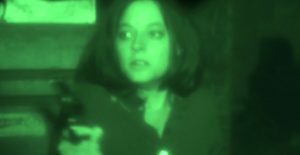
Clarice! He’s watching you! Geez, that’s scary.
As a writer, I find it difficult to write a scary or suspenseful scene. It’s because I (theoretically) know what’s going to happen. Or at least I control the outcome. But I have faith in the writing process. Another Elvis Costello line? “Imagination is a powerful deceiver.” It’s also a powerful informer when it comes to fiction. One of my writing philosophies I think comes from my response to scary movies — less is more. The unseen is what sparks a reader’s imagination.

The shadow can be scarier than what throws the shadow. This image for the cover of No News is Bad News won out over a photo with an actual hunting rifle in it.
The cover art of the first two books in my Bernie O’Dea mystery series have photos that the publisher and I hope evoke the feeling that something bad is going to happen. For the second book, No News is Bad News, we agreed that a photo of a shadow of a man with a gun — a hunter? Or something else? — would trip people’s imaginations more than showing an actual gun or person. My books don’t have classically “scary” scenes, but do have ones I hope are suspenseful enough to give readers a case of the willies. At least the first two. We’ll see what happens in the third, which I’m writing now. In all my scenes, not just the suspenseful ones, I try to let readers’ imaginations take over by not over-describing, but providing enough information and using the right words in the right way to allow readers to form their own pictures. I often say that a reader’s imagination is much more powerful than my words. My words, if done right, are what sparks that imagination and allows it to fill out the scene.
So I guess the scariest thing of all? What’s in our own heads just waiting to come out.
Lea Wait: Definitely what’s in our heads! I have (and have always had) strange, and often scary, nightmares. Have even included a couple in my protagonists’ heads. But, on a practical basis, what am I scared of? Centipedes. Millipedes. Yuck! A few times in my life I’ve had to deal with enormous creatures of these varieties, and it wasn’t fun, even though I was victorious. I’m also scared of mobs. Of large angry dogs. Of heights. Of “amusement center” rides that involve buckling yourself in and then being dropped from heights, careened through the air, or in any other way leaving yourself at the mercy of others.
Which may be my biggest fear. Losing control of myself … or dealing with people who have no self control, or who take their anger out on others.. Fear and anger are close to synonyms in my world. Interesting to think about.
Kate Flora: I blame the cops. Yup. I used to live in such a safe and blissful bubble. But now, having spent the past twelve years writing books about real crimes with cops, I see the world differently. Then there were those classes–the citizen’s police academy and my RAD self-defense class. There’s nothing like tuning up your awareness to infuse the world with danger. Where I might once have crossed a dark parking lot thinking about where I’d just come from, now I see the shadows and check around my car. I walk with my keys woven between my fingers. I jump in quickly and lock the door. I listen for the sounds of someone breathing. When I walk down mostly empty streets, I listen to the footsteps around me. If I can, I use store windows as mirrors to see who is around me. If I am home alone, the creaking of the old house is ominous. There is always someone outside and I am too well aware of the possibilities of someone slipping into the garage as I am turning off the car and gathering my things to go inside. What scares me? The possibilities of a perfectly normal day suddenly turning dangerous. My own imagination.
now, having spent the past twelve years writing books about real crimes with cops, I see the world differently. Then there were those classes–the citizen’s police academy and my RAD self-defense class. There’s nothing like tuning up your awareness to infuse the world with danger. Where I might once have crossed a dark parking lot thinking about where I’d just come from, now I see the shadows and check around my car. I walk with my keys woven between my fingers. I jump in quickly and lock the door. I listen for the sounds of someone breathing. When I walk down mostly empty streets, I listen to the footsteps around me. If I can, I use store windows as mirrors to see who is around me. If I am home alone, the creaking of the old house is ominous. There is always someone outside and I am too well aware of the possibilities of someone slipping into the garage as I am turning off the car and gathering my things to go inside. What scares me? The possibilities of a perfectly normal day suddenly turning dangerous. My own imagination.
Jen Blood. Bats, man. No, not Batman. Bats. I used to be a lot more terrified of them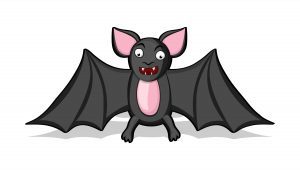 than I am now – when I was younger, the first sight of those fuzzy winged beasts would send me cowering to the floor. One night when I was home alone with my mom, one got in and I recall being on all fours on the floor, a pot on my head (they nest in your hair, you know! And suck your blood. And turn you into face-melting monsters), waving a broom around in a vain effort to shoo it out the open front door. All the while convinced it would call all its face-melting buddies, and the house would be swarmed.
than I am now – when I was younger, the first sight of those fuzzy winged beasts would send me cowering to the floor. One night when I was home alone with my mom, one got in and I recall being on all fours on the floor, a pot on my head (they nest in your hair, you know! And suck your blood. And turn you into face-melting monsters), waving a broom around in a vain effort to shoo it out the open front door. All the while convinced it would call all its face-melting buddies, and the house would be swarmed.
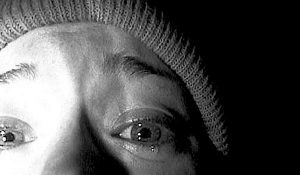 On another occasion, I went to see The Blair Witch Project with a friend in Portland, then returned that night to the empty log cabin I was housesitting in South Thomaston. Not a stellar plan. I woke up in the middle of the night and the power was out. Of course, I was convinced it was the Blair Witch (and yes, I was an adult). I grabbed my contact lenses and my dog Moonshadow, and locked us in the pickup truck while I put my contacts in. Then headed back to my mom’s place in the next town. The only problem was that the power outage spanned a couple of towns, and I just remember driving along 131 and then Route 1 seeing no lights…anywhere. And half laughing at myself, half dreading that it might be true, thinking that the Blair Witch had come and taken out the whole damned Midcoast.
On another occasion, I went to see The Blair Witch Project with a friend in Portland, then returned that night to the empty log cabin I was housesitting in South Thomaston. Not a stellar plan. I woke up in the middle of the night and the power was out. Of course, I was convinced it was the Blair Witch (and yes, I was an adult). I grabbed my contact lenses and my dog Moonshadow, and locked us in the pickup truck while I put my contacts in. Then headed back to my mom’s place in the next town. The only problem was that the power outage spanned a couple of towns, and I just remember driving along 131 and then Route 1 seeing no lights…anywhere. And half laughing at myself, half dreading that it might be true, thinking that the Blair Witch had come and taken out the whole damned Midcoast.
I have lots of stories like that. The night I went to see Pet Semetary with my teen BFF Nicole, I came home and refused to let our big black cat Kammi sleep inside — which I still feel bad about. While housesitting for another woman whose apartment I found sort of terrifying, I took every single painting off the walls and stowed them in the back bedroom until she came home, because it seemed entirely probable that one of those creepy-ass paintings would come to life and murder me in my sleep.
Nowadays, I don’t watch scary movies. I genuinely like bats, thanks to that children’s book Stellaluna. It seems that as I’ve gotten older, those fantasy frights have lost their teeth, and it’s the real stuff that gives me nightmares: death, taxes, the bad things that happen to good people on a daily basis. I still secretly harbor the belief that those old paintings could come to life in the night, though. I’m not ready to give that one up yet.
Bruce Robert Coffin: What scares me? Trying to top the list of fears preceding mine! No, in all seriousness I love a good horror story. Doesn’t matter what type really. Haunted houses, demonic possessions, crazed killers, they all work for me. And in all honesty the format in which it’s told doesn’t matter as long as it’s done well. Novels, movies, even audio can be effective mediums for scaring the hell out of me. I can still remember sitting around the phonograph, huddled together with my friends, at Dunstan School Library listening to the Alfred Hitchcock Mystery LPs.
 I can happily say I’ve never outgrown this love of scaring myself. I still love watching a horror movie at night, alone. Nothing better. Those things don’t scare you? Really? Try watching the Exorcist right before bed tonight without thinking about what might be lying in wait under under yours… Sweet dreams.
I can happily say I’ve never outgrown this love of scaring myself. I still love watching a horror movie at night, alone. Nothing better. Those things don’t scare you? Really? Try watching the Exorcist right before bed tonight without thinking about what might be lying in wait under under yours… Sweet dreams.
October 28, 2016
Weekend Update: October 29-30, 2016
 Next week at Maine Crime Writers, Monday’s post will be our annual Halloween Special. Then there will be posts by Kaitlyn Dunnett/Kathy Lynn Emerson (Tuesday), Maureen Milliken (Wednesday), Barb Ross(Thursday), and Dick Cass (Friday).
Next week at Maine Crime Writers, Monday’s post will be our annual Halloween Special. Then there will be posts by Kaitlyn Dunnett/Kathy Lynn Emerson (Tuesday), Maureen Milliken (Wednesday), Barb Ross(Thursday), and Dick Cass (Friday).
In the news department, here’s what’s happening with some of us who blog regularly at Maine Crime Writers:
Saturday, October 29, and Sunday, October 30, Kathy Lynn Emerson/Kaitlyn Dunnett and Lea Wait will be at the REM Craft Fait, Champion’s Fitness Club, 30 Elm Plaza in Waterville, Maine. Saturday: 10-5, and Sunday, 10-3. Lot of crafts — and books! for your personal and holiday gifting pleasure!
Tuesday, November 1, Lea Wait will be speaking about her Mainely Needlepoint mysteries from 6:30 until 8:00 p.m. at the Dyer Library (371 Main Street) in Saco, Maine. Her books will be available for purchase and signing.
Saturday, November 5, Lea Wait and Barbara Ross will be signing their books from 1 until 3 p.m. at Sherman’s Maine Coast Books (158 Main Street) in Damariscotta, Maine.
An invitation to readers of this blog: Do you have news relating to Maine, Crime, or Writing? We’d love to hear from you. Just comment below to share.
And a reminder: If your library, school, or organization is looking for a speaker, we are often available to talk about the writing process, research, where we get our ideas, and other mysteries of the business. Contact Kate Flora
October 27, 2016
The Joys of NaNoWriMo: You Have Permission to Suck
 Kate Flora: A pretty provocative statement, yes? So I guess I should explain. Yesterday was a cold, rainy, miserable day and I was wrestling with a manuscript that felt like an octopus with a thousand legs. Or arms. Or both. I couldn’t handle it, subdue it, make it behave in any way, and the process was making me grouchy. Then I decided I’d write this blog post, and stared at the blank screen and couldn’t come up with an idea. So I went to my friends on Facebook and asked for help.
Kate Flora: A pretty provocative statement, yes? So I guess I should explain. Yesterday was a cold, rainy, miserable day and I was wrestling with a manuscript that felt like an octopus with a thousand legs. Or arms. Or both. I couldn’t handle it, subdue it, make it behave in any way, and the process was making me grouchy. Then I decided I’d write this blog post, and stared at the blank screen and couldn’t come up with an idea. So I went to my friends on Facebook and asked for help.
Help they did, of course. I now have enough topics to carry me through to the New Year. And the first one was so absolutely timely that I decided to take it up: Tips for NaNoWriMo.
In case there is a soul somewhere on the planet who doesn’t know, NaNoWriMo stands for National Novel Writers Month. Every November, writers sign up to write a 50,000 word novel during the month. Signing up means you’ll probably be put into a group where you can go to meetings if you want that for support, and you will be able to log in to chart your word counts and your progress, and get encouraging e-mails throughout the month.
The internet is absolutely full of advice about how to prep for NaNoWriMo, how to do  NaNoWriMo. So much advice, in short, that you could probably write a novel using the tips as prompts or just aggregate the advice into a short book. Or is that aggravate? Because with so much advice out there, it can be aggravating. Confusing. Overwhelming. And pretty often, those who are offering the advice are quite certain that they are right.
NaNoWriMo. So much advice, in short, that you could probably write a novel using the tips as prompts or just aggregate the advice into a short book. Or is that aggravate? Because with so much advice out there, it can be aggravating. Confusing. Overwhelming. And pretty often, those who are offering the advice are quite certain that they are right.
Should you outline in advance? Have the plot of the work all sketched out? Perhaps have it all storyboarded and taped to your office wall?
The possibilities are endless. And the bottom line, in my opinion, depends entirely on what kind of a writer you are. Or, if this is an early foray into the world of writing, what kind of person you otherwise are. Do you like to do a lot of prepping or do you like sail into an adventure and wing it and see what life brings?
On your behalf, I went out and waded through a bunch of those advicely blogs. And like a retriever, I have brought back the wisdom that speaks to me. You can snap up my thoughts and make them your own, or go atrolling for yourself.
 So here, in no particular order, are the bits of advice that I think are most useful if you are going to have fun with NaNoWriMo.
So here, in no particular order, are the bits of advice that I think are most useful if you are going to have fun with NaNoWriMo.
Embrace a new mindset.
Answer “YES!”
Just start and keep going.
Silence your editor, that picky little voice that tells you you’re doing it wrong. If necessary, draw a picture of your editor and stick pins in it. Be silly if you need to be. This is your adventure. Own it.
Write fearlessly.
Write “TK” for missing facts. Don’t stop to look things up. Don’t obsess over what you can’t remember. You can fix all that later.
Embrace Anne Lamott’s advice: it’s okay to write a shitty first draft. You can edit a draft and make it better. You can’t edit a blank page.
Embrace the word discipline.
For once, elevate quantity above quality. Don’t edit. Just keep going. Do keep track of your word count. It’s part of the game.
Keep telling yourself: The Perfect is the Enemy of the Good
Remember that you’re not trying to win, you’re trying to be
Don’t let the risk of obsession scare you off
You have permission to suck. Who cares. You may make amazing discoveries in the process.
Unplug. No phone calls. No checking e-mail. No selfies.
Exception: You can make yourself, or your story, a playlist. It can become part of the ritual.
Write in the same place if you can, because the ritual of place can become part of the ritual of writing.
Finally, a bit of heretical advice. The rules say you’re supposed to write something new. But you are writing for you, not for them. If you’ve got the half-finished story in the drawer you’ve never had time to get back to…you are allowed to take it out and finish it. (Don’t tell them I said this.)
November. Your month. You’re the writer. The only thing you have to do is honor your desire to write by giving it the time it deserves. And see where story takes you.
A lot of advice is about prepping…but hey, you’re out of time, and about not bothering agents or editors with your unedited glop at the end. But you wouldn’t do that anyway.
Here are a couple of blogs I used to compile the above. And below, a snippet from a book I wrote during NaNoWriMo one year.
http://terribleminds.com/ramble/2011/10/04/25-things-you-should-know-about-nanowrimo/
Runaway
Air-horn blaring, the eighteen-wheeler came barreling at her out of the dark. Callie yanked the wheel, adrenaline surging, as she rocked back into her lane. The Jeep fishtailed wildly as she fought for control. Horn still blaring, the truck rushed past and disappeared into the night. Her breath quick and shallow, nerve-trees tingling, she clung to the wheel. Adrenaline carried her on its sharp, acid flow for another mile before it faded, leaving her drained and alone in a night as dark as Galen’s heart. Then, arms trembling, she abandoned her determined press forward, pulled onto the unpaved shoulder and parked, numb from exhaustion. All she could feel was the biting pressure of her nails–hard, sharp slices of sensation–against the palm of her hands. She had no idea where she was or where she was going. Her only plan had been to keep moving, putting time and distance between herself and the mess her life had become.
How long had she been driving? Ten hours? Twelve? Drive too long without a break and your eyes start playing tricks. You see things that aren’t there, like patches of blood spreading across the road, and you don’t see things that are, like eighteen-wheelers coming at you like Leviathan from the depths. She should get out. Stretch. Walk around in the cold night air and wake herself up. Her body resisted the urging of her brain, stayed inert in the seat.
The night was pure black. No streetlights. No house lights. Wind battered the car, rattling the wipers, panting to get at her as it tore away dried leaves that had sheltered in the depression below the windshield. She watched, eyes at half-mast, as they rustled across the glass like the small animals. It was cold out there. Before she shut off the engine, she’d seen the outside temperature was 38.
She’d left Pennsylvania running on an instinct born of desperation. Get out of town, away from the suspicious looks, the comments, the humiliation. Out of her ransacked apartment and her shredded life. Several hundred miles later, she’d run out of gas—spiritual gas, not petroleum—here on this lonely roadside somewhere in Vermont.
The whole ugly mess had exploded on her a few weeks ago, when she’d woken one morning feeling drugged and groggy, not to her fiancé Galen’s head beside her but to a barren apartment, a stripped office, emptied bank accounts, and note, pinned to his pillowcase by a chip clip that said, “Thanks for everything.”
Double Gut Punch
John Clark looking at a couple recent young adult titles that exemplify how strongly the genre is addressing changes in the way teens look at the world, each other and their peers. If you’re my age or thereabouts, you probably cut your teeth on Nancy Drew or the Hardy Boys. Think back for a moment, did Nancy even know what a tampon was? Were Joe and Frank ever cautioned about STDs? Bet not.
While most of the challenges today’s teens face have been around forever, acceptance, discussion and awareness of/about them was ignored. The world is a scary place these days, made more so by instantaneous communication. Less than five minutes after a horrific shooting, plane crash or bomb going off, details (sadly often inaccurate or graphic) are all over social media. This change is here to stay, but I’m a firm believer in how good fiction can be helpful in not only opening eyes about issues, but in reassuring teens that whatever differences they may have on a physical or emotional basis, they’re neither unique nor alone.
The first book was brought to my attention by my friend Brian Katcher on his Facebook page a week ago. Brian has written some terrific YA books, some funny, some very emotional (his Almost Perfect is among my ten best YA books read of all time). He hooked me with his post and I ordered it on the spot. Look Past, (Running Press Teens, 2016. ISBN: 9780762459216) is written by Eric Devine, a high school English teacher. Avery, the protagonist, is a transgender boy who came out several years ago. His family is very supportive including his uncle Tom, a member of the local police force. School is still sometimes a war zone, particularly because of homophobia, lack of understanding and a lot of kids from religious fundamentalist families.
When Avery was younger, he was very close to Mary Mathison, daughter of the local fire and brimstone minister. She loved Avery, despite her background and her feelings were reciprocated. When they shared a first kiss while swimming in a stream behind her house, they were caught by Reverend Mathison. Mary was punished and even though it was clear to Avery that she still cared for him, the connection was essentially severed. Fast forward to junior year. Avery has a new girlfriend, Beth, and a best friend, Charlie. He and Charlie share a love of forensics and Avery knows that Charlie has never gotten over the loss of his mom. Neither has Charlie’s dad, who alternates between lashing out at his son and withdrawing.
The book opens with Avery, Beth and Charlie participating in a ground search for Mary who vanished a week ago. Avery expects the worst. When a hunter, involved in the search, follows a hunch and veers away from his assigned area, he finds her. Mary’s not only dead, but pieces are missing and a bible passage written on paper has been inserted in her mouth.
Thus begins a gritty, profane journey for all concerned, but mostly for Avery. Not only is he tormented by text messages from the killer, but he also finds himself reliving every memory he had with Mary, wondering whether he could have done something to change the outcome.
While a mystery, this is also one hell of a good look at how life is for a transgender teen. You get to see Avery at his best and his worst as well as understand what transitioning is like, not only from a physical, but an emotional standpoint. In fact, I was so focused on the dynamics between Avery and the other main characters that the solution snuck up on me. This is a definite book for Edgar consideration next year.
The other book is the first in a trilogy and I’m eagerly awaiting arrival of the other two. Courage In Patience by Beth Fehlbaum (Steady on Books; Revised First ed. edition (March 29, 2016): ISBN: 9780997387100). Ashley Asher is terrified more often than not and has good reason to feel that way. Her dad has never really been in the picture, her mom has crappy taste in men and her stepfather, Charlie, is a leering monster. He’s been after her since she was nine, knocking holes in walls so he can spy on her in the bathroom and her bedroom. Inappropriate touching is part of her life, but now Charlie has ramped things up to a really scary level. Ashley’s mother refuses to believe anything she tells her, making her living situation even worse.
When Charlie rapes her, she’s bleeding badly and escapes to her friend’s house. Lisa has started to get irritated with Ashley because their friendship seems one-sided. Ashley stays at her home a lot, but never invites Lisa to her place. When She sees the incriminating note written by Ashley’s mom, Lisa begins to understand how bad things are for her friend. They end up seeking help from a trusted teacher who gets Ashley to the hospital and involves both cops and child welfare. Unfortunately, Charlie and Mom’s lies trump Ashley’s story. Fortunately, the teacher, Mrs. Chapman, takes Ashley’s side and forces child services to locate her real father who lives a couple hours away in the small town of Patience, Texas.
What Ashley discovers is that Dad freaked out when he became a father and as a result didn’t handle things well. Her mother never told her much about him, only that he was bad and untrustworthy. In the interim, He’s grown up, dealt with drinking and anger issues and remarried. When he learns what has happened to Ashley, he’s there as soon as possible and promises her that he’ll do everything possible to make up for his absence and what happened to her courtesy of Charlie.
Ashley’s reluctant to trust, but Bev, her stepmom is a gem. She’s an English teacher who just found out she has to teach a summer lit course. Ashley, eager to find some normalcy, asks to enroll and a bonding between them begins. Likewise with her younger stepbrother, Ben, starts out not knowing how to deal with what happened to her, but soon becomes a real sibling defender.
This is a book not afraid to cover graphic details about abuse, the aftereffects and the insanity of a parent so desperate for male attention that she would sacrifice a child to get it. As readers follow Ashley’s slow and painful steps out of fear and mistrust, they meet some wonderful (and a few not so wonderful) people) The kids Ashley meets in the summer lit class are diverse and cover the spectrum from slacker, to eager to be perfect, to having issues close to what Ashley faces. Bev does a great job of forcing everyone in the class to engage by using Chris Crutcher’s Ironman as the topic book. Her strategy is not without repercussions, but read the book to find out about them as well as how Ashley’s journey unfolds. It’s a great book about the trauma of sexual and emotional abuse, perfect for teens who have been there or who have friends that have.
October 25, 2016
Mystery Loves Company
Dorothy Cannell: A few weeks ago a friend from England came to visit and gave me, 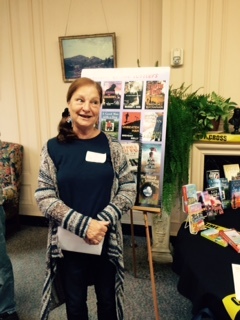 perhaps in hope of breakfast in bed, a page from The Times, Monday October 3, 2016 written by David Sanderson under the headline “And Then There were … Plenty.” Set below is the opener:
perhaps in hope of breakfast in bed, a page from The Times, Monday October 3, 2016 written by David Sanderson under the headline “And Then There were … Plenty.” Set below is the opener:
“The best known novels of Agatha Christie are being revived for new film and TV audiences writes David Sanderson…. For once the culprit is obvious. It was Agatha Christie in her study with an astonishing output of drama and intrigue.
“The author’s murder mysteries are set for a multi-million pound, 21st century makeover after her estate signed a string of film and television deals. The names in the frame are a who’s who of Hollywood including Sir Kenneth Branagh, Ben Affleck, Dame Judi Dench and Johny Depp.
“There are at least four feature films in the pipeline, plus a seven-programme adaptation deal with BBC, and another Hercule Poirot continuation novel.”
In my thoroughly biased opinion as an enthusiast of Christie’s work I think this news calls for a National Day (if not year) of The Mystery. What mainstream writer of her era is in her league when it comes to garnering fans not born until yeaCrs after her death in 1976? To have escaped becoming dated, as has been the fate of many from her era, is an inspiration to today’s mystery writers.
A quote from Hilary Strong, chief executive of Agatha Christie Limited, caught my attention:
“There is a darkness to the work that has not necessarily been interpreted by the film makers before…And Then There Were None is actually the grandmother of horror.”…. She was a social historian, and there is the wonderful sense of humour. Sir Kenneth [Branagh], who is directing and starring in a new film adaptation of Murder on the Orient Express, agreed that there was an edge to Christie’s work. He described the novel as ‘mysterious, compelling and upsetting,’ adding that he was honoured to be bringing ‘these dark materials to life for a new audience.’’’
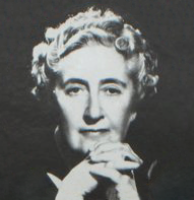 I have frequently been involved in writers’ chit-chat as to whether Cristie’s mysteries can be labeled cozies. My take on The Body in the Library has long been cozy title to fit setting and grim plot, and that’s what I took from this article – that she can’t be slotted into any niche. She was the whole package – unique until some other writer can work out how she wove her magic.
I have frequently been involved in writers’ chit-chat as to whether Cristie’s mysteries can be labeled cozies. My take on The Body in the Library has long been cozy title to fit setting and grim plot, and that’s what I took from this article – that she can’t be slotted into any niche. She was the whole package – unique until some other writer can work out how she wove her magic.
Upcoming Feature Films: Murder on the Orient express; Witness for the Prosecution, And Then Were None, Crooked House.
BBC TV Adaptions: Ordeal by Innocence, Death Comes As The End, The ABC Murders.
On a personal note, huge thanks to PBS for the many wonderful British programs they provide. Currently loving Poldark and The Dr. Blake Mysteries on Thursday nights.
All best wishes, Dorothy
October 24, 2016
Character Building
Vaughn Hardacker here: One of the things that will turn me off on a book is Tom Swift style characters, you know the hero who excels at everything they have ever done. You know The Great Leslie Gallant character of the Warner Brothers 1965 movie THE GREAT RACE. The movie is one of my all time favorites and it is great satire. However the characters are all shallow. Tony Curtis as Great Leslie is the protagonist and Jack Lemmon as Professor Fate Leslie’s nemesis and antagonist. Are satirical illustrations of the heroes and villains of silent films. The problem is they are one dimensional (albeit I believe intentionally so).
As writers we must never forget that people are not one or even two dimensional, they are multi-faceted. They have hopes and fears, hates, likes and failures. Yet, when we think
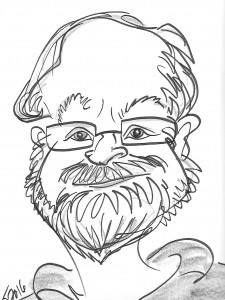
Vaughn
of their personalities, we tend to key on one or two dominant traits. We describe someone we know to another person as, “He’s the pushy one.” Or “She’s so sweet, but a bit ditsy.” It’s what, in our minds, makes these people individuals to us.
So, too, the characters we write are multi-faceted. When we write them as such, they all blend one into another, with no personality distinctions. Their physical attributes are different, but you could probably swap around and notice little difference. The most recent rejection letter says, “Your characters are cookie cutter.” Of course, in your mind, you (as the writer) see all these “people” as distinct.
Remember the way we describe people? Define your characters the same way. Give your hero two or three traits. That’s all. Give him two good and one bad (or two bad and one good, if your character is evil). Lesser characters get fewer traits.
I’m currently working on a novel where my protagonist is moral (good) and long-suffering in patience (good), but when he’s had enough, he’s brutal (bad). My antagonist, by necessity is almost the opposite: arrogant (bad) and insecure (bad), which makes him a bully.
I try to make all of my writing character driven (we sort of have to, after all virtually every plot today is derived from Shakespeare), so even though there’s a “bad guy” in my Bouchard and Houston novels one of my readers’ favorite characters is an anti-hero. Jimmy O could easily be the antagonist. However, as interesting as many of my readers have found him, he’s a supporting character (they get only two traits, in Jimmy O’s case he can be brutal and violent while on the other hand uses that trait to help people less fortunate as he). He is as a member of one of my writing groups said: a gangster with morals.
It’s important to remember that sometimes stories change as we write them. A minor character (Jimmy O) could suddenly become important and move into a supporting character role. If this happens, give that character one more trait. But only one; you don’t want to interfere with the importance of the primary characters.
Likewise, a supporting character may fall back to supporting status. In that case, focus on just one of his chosen traits.
The most important thing to remember is what is your character’s role in the story…does his or her presence move the story forward? If you don’t know that, then your characters will have too many traits and once again, they’ll become cookie cutter people with different roles.

